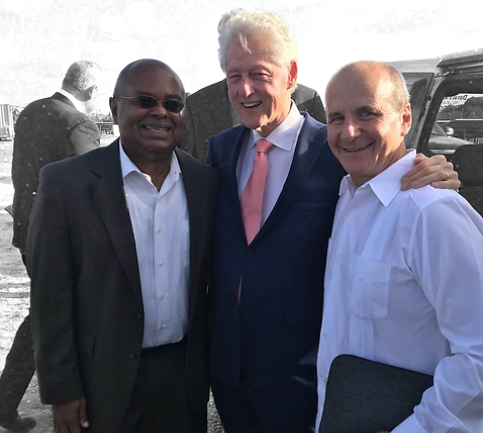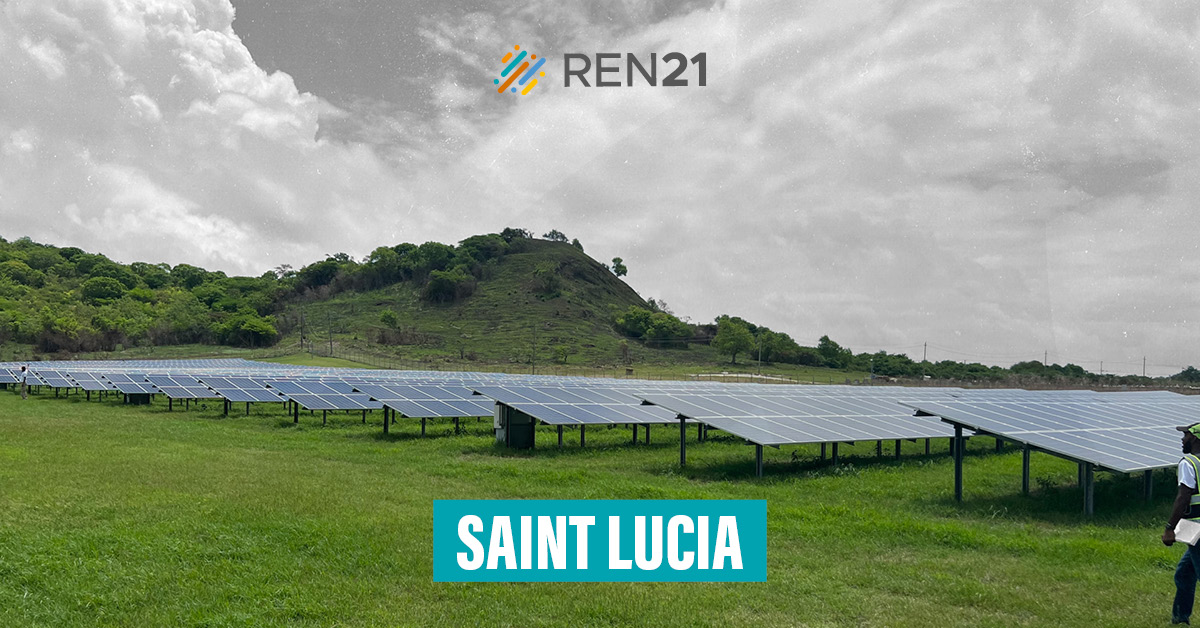As a small island developing state, Saint Lucia’s vulnerability to the impacts of climate change sparked James Fletcher’s initial interest in renewables and the energy transition over 16 years ago. In the time since, he has worked both within government and outside it, forging valuable international partnerships to facilitate a just green transition in Saint Lucia.
Saint Lucia’s relationship with renewable energy goes back as far as the 1970s, but Saint Lucia had not managed to make much progress on its renewable journey until James Fletcher came into government in 2011. Through his role as Saint Lucia’s Minister of Sustainable Development, Energy, Science and Technology, Fletcher paved the way for a just renewable transition between 2011 and 2016.
The looming cloud of fossil fuel prices
Saint Lucia’s dependence on imported fossil fuels to run its grid made their economy very dependent on fossil fuels, and highly vulnerable to price surges in response to geopolitical or supply chain disruptions.
Against this backdrop, Fletcher saw an opportunity to use renewable energy as a means to improve Saint Lucia’s economy by increasing energy security while simultaneously creating green jobs.
“When I became Minister in 2011, I found a country that had been doing reasonably well,” recalls Fletcher. “But there was always this looming cloud being the high cost of electricity.”
It was clear that reducing electricity costs would be critical for Saint Lucia’s success. The island’s economy depended primarily on tourism and the services industry, and keeping these sectors running required a lot of power and fuels for transportation, lighting and cooling in hotels.
“When you’re paying 40 US cents per kilowatt hour for electricity, then that makes you very uncompetitive despite everything else. So we always felt that we needed to bring that price of electricity down because that was such a major input for all of our economic sectors, especially tourism.”
Safeguarding a just transition
Previous exploration of renewable energy options in Saint Lucia provided fertile ground for Fletcher and his team to identify viable renewable energy sources to bring about a renewable transition.
When high development costs of their geothermal energy site and its location in a sensitive UNESCO World Heritage site posed early challenges, Fletcher’s team referred to previous explorations into wind and solar to increase the renewables in their energy mix.
However, readying Saint Lucia for a renewable energy transition required a suite of changes that extended far beyond switching fuel sources. Embarking on the renewable transition meant dealing with complicated questions such as who gets to benefit from the reduction in energy prices first: the big producers or the average person.
“The recommendation to us was that it be the big producers to make sectors more competitive,” says Fletcher. “If they get more money in their pocket, they can expand their operations, they can hire more people. There are all these arguments, but I always felt that it’s a little unfair because, as a proportion of their income, their spend on energy is less than the average person who’s spending a lot more of their disposable income on energy.”
Fletcher’s dedication to ushering in a just transition became a North star. Rather than allowing big producers such as hotels to rapidly switch to renewables and move off grid, Fletcher prioritised developing a regulatory apparatus that allowed people living on the margins and below the poverty line to benefit from the energy transition as well.
Brokering outside investment
The new legislation needed for the renewable transition was extensive. Fletcher needed to systematically redevelop a new suite of modern electricity legislation and regulatory apparatus. Everything from the tariff structure and interconnection agreements to the electricity supply services bill and consumer protection legislation needed to be written.
Given the extensive changes, Fletcher’s Ministry decided to work with the previous government’s energy policy, and maintain a positive relationship with LUCELEC, the national electricity supplier.
“There’s always a temptation when new governments come in to go out with the old and come in with something new. But I was very conscious as Minister that we really did not want to throw out the baby with the bathwater,” he says.
This ensured the Ministry could focus on overcoming what Fletcher described as “human resource challenges” of being a small island developing state, and finding investors and organisations genuinely interested in supporting Saint Lucia’s transition.
“People were fighting to see who could get the best part of the pie,” says Fletcher. “We had to find a way to attract good credible investors and weed out those who were just coming in to take as much profit out of this as possible.”
Thanks to partnerships with international organisations including the World Bank, Richard Branson’s Carbon War Room, the Clinton Climate Initiative and the Rocky Mountain Institute, Fletcher received invaluable advice on how to navigate the transition to renewable energy.
With their guidance, technical advice and expertise, Fletcher could advocate for the most ambitious renewable energy agenda possible, while also receiving comprehensive investment across all areas of their transition.
“They knew who the players were and could help us avoid the pitfalls. I think that really steered us in the right direction on this energy journey.”

Carrying the torch for renewable energy
Fletcher held his position as Minister for Sustainable Development, Energy, Science and Technology up until 2016. In the years since leaving government, he has remained committed to advocating for a just transition to renewables in Saint Lucia.
For him, the switch to renewable energy now extends beyond the economic benefits to Saint Lucia to the country’s positioning on the global stage.
“In Saint Lucia, the argument for transitioning away from fossil fuel argument is not so much focused on mitigating greenhouse gas emissions. Saint Lucia produces .008% of global greenhouse gas emissions, and most of the other islands in the Caribbean are the same. But we felt that it was important to give us that moral authority when we attend COPs, when we attend environmental meetings, to say that if we, who really are not contributing, can make that sacrifice, can find the money, can put the effort into totally decarbonising our economy, so can you.”
However, maintaining momentum on the renewable energy transition is not easy, especially given the looming threat posed by Saint Lucia’s position in the middle of a hurricane zone.
“Every year between June and November, we have to deal with the ominous prospect of a hurricane passing through and undoing 10-15 years of hard work. For example, when Hurricane Maria went through Dominica, it caused damage that is equivalent to 226% of that country’s GDP. That’s twice the annual economic output of that country wiped out in the space of 24 hours.”
Against this backdrop, the new government’s progress towards renewable energy has stalled.
“People kind of lose sight of the importance of the energy transition when they are bombarded with so many other issues that the government in the small island has to deal with,” says Fletcher. “I haven’t seen the urgency. I haven’t seen the same level of enthusiasm for the energy sector that was there previously.”
Although progress has slowed, Fletcher remains confident that Saint Lucia can one day get to 100% renewable energy capacity, especially with the support of renewable energy champions.
From his experience, Fletcher draws two important lessons for any energy minister embarking on the energy transition: to secure national cross-party commitment to a renewable transition and to cultivate at least one energy champion.
“You need an energy champion who could help all of the other ministries and the Prime Minister understand the pivotal role that energy plays in all of these discussions, and help them connect the dots so they can really build out the energy sector.”
These champions can continue advocating for renewables, turning renewable energy transition projects from something that is done by one political party into a national commitment.
Cultivating these champions in the current focus of Fletcher’s work. By setting up youth projects in the Caribbean through his Caribbean Climate Justice Project and Youth IRIE – Innovators for Renewable and Inclusive Energy, Fletcher is sowing the seeds for new generations of renewable champions who can continue to advocate for a renewable and just energy transition.
The transition to renewable energy is possible and it is happening right now. Read more stories from our renewable energy champions.










